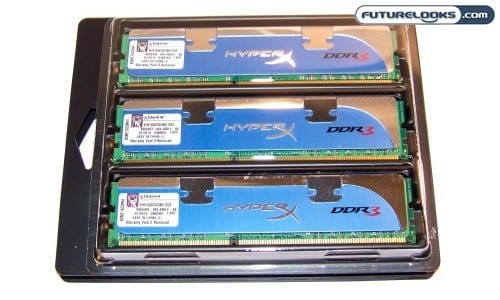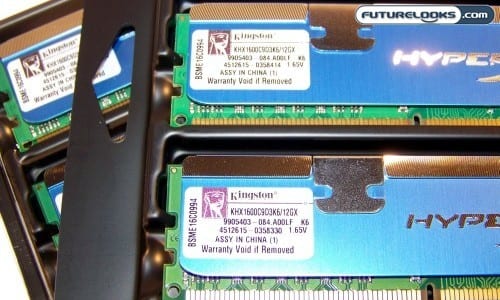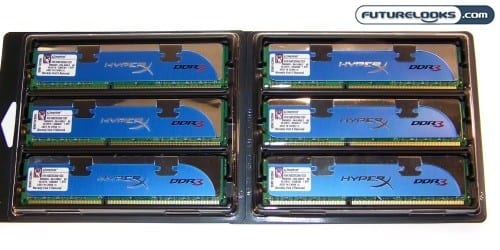
I often hear both consumers and industry professionals tell you that you can’t have enough memory. If you have deep pockets, then sure, why not max out those slots. But if you’re on a budget, then there is a line where diminishing returns take place. Not to mention, if all you do on your computer is web browsing and emails, there isn’t a whole lot of benefit to maxing out the RAM. Even many games don’t benefit from a ton of PC memory. So who’s gaining the most from lots of RAM?
Some folks really do find themselves in situations where a ton of RAM does make a difference. They work with really resource intensive programs that quickly use up more than the seemingly standard 4GBs of memory. They may be professionals that edit and render large amounts of audio and video or who run multiple VM sessions. These are the users who would and could benefit from using the Kingston HyperX 12GB 1600MHz DDR3 “Dual-Triple” Memory Kit.
Features and Specifications
The KHX1600C9D3K6/12GX comes in two separate packages with three 2GB modules in each package. For those who are weak in the maths, that’s six 2GB modules in all totaling a healthy 12GB.

It bares noting that this is a 1600MHz memory kit versus the commonly found 1333MHz kits. One of our astute Futurelooks IRC Channel folks asked why someone didn’t make 1800MHz and faster memory kits. Well, to put it bluntly, it would be pointless. First, the current processor’s memory controllers are maxed out, or spread thin when all the DIMM slots are occupied. Second, all-purpose professional users won’t be overclocking their systems. They require stability above anything else.
The timings of the kit are 9-9-9-27 right out of the package. All six kits are also tested to be equally compatible with each other. We’ve seen instances where tuned CAS 9 kits actually functioned perfectly well when manually set to CAS 8, or 8-8-8-24 timings. We’ll check that out for you in testing. There could be a little extra hidden value inside.
Checking Out the Modules
Normally, we’d like to show you what’s in the packaging. But, this is a pretty simple bundle. Again, two packages containing three modules each.

You can see that the modules are nicely wrapped in the HyperX ‘Blade’ heat spreaders. The Kingston blue color still contrast nicely with many motherboards out there. And in some cases, they match others like the latest X58 and P55/P55A motherboards from GIGABYTE and others.
Themes aside, there’s a lot you can do with this much memory. For one, with a good Windows 64-bit Vista or 7 installation, programs will load quicker and can stay loaded before swapping to the hard drive. The 64-bit operating system will allow far more programs to stay ‘cached’ at all times whereas 32-bit users with smaller amounts of memory cannot. You can also multitask to your heart’s content, popping open program after program.
And that’s why professional users tend to be the folks commonly using this large amount of memory. They don’t have time to open and close programs to make room for the next task. Their content needs to be ready, on hand, and accessible at all times without crashing.
Another symptom of low memory performance can often be seen in desktop and laptop computers with 512MB to 1GB. If you have too many programs starting up and not enough memory, your computer will come to a crawl as it tries to prioritize, often swapping to the much slower notebook hard drives. That can be very frustrating especially if it’s a Vista OS that requires about 800MB of memory right from boot.
Installation Information
RAM is the easiest component to install in your computer. The hard part is making sure you picked the right memory for your board.
Even if your motherboard has 6 x DIMM slots, it may not be able to support a 6 x 2GB memory kit. The P55 and P55A series with 6 DIMM slots, for example, can’t support a full bank of Level 2 memory. Level 2 memory has modules on both sides (2GB stick), while Level 1 has modules on one side (1GB stick).
If you want a full 16GB configuration on your P55/P55A motherboard, you’ll have to pick up some 2x4GB memory kits. Just be prepared to pay the hefty price premium. Otherwise, we did confirm 5 x 2GB modules will work perfectly.
For this reason, the six piece 12GB 1600MHz kit is intended for Core i7 systems with the X58 Chipset. That’s because the X58 board fully supports most any “Level 2” memory module combination in all six DIMM slots as long as you don’t exceed the board’s maximum supported memory.
Of course, if you only have a 32-bit OS installed, using more than 4GB of memory is pointless as it will only access about 3.5GB at most. So, you would be wasting your money and the 12GB kit’s potential unless you install a 64-bit OS. Might we strongly, strenuously, recommend Window 7 64-bit or another true 64-bit OS of the “penguin” variety, to take full advantage of these modules.
Test System Setup: 6GB vs 12GB
In previous generation motherboards, performance suffered when populating all the memory slots. We figure that the best way to explore this on the X58 platform and compare performance in 6GB and 12GB configurations. Naturally, testing will be done within a 64-bit operating system environment with Windows 7 64-Bit.
Here are the test system specifications:
- Intel Core i7 975XE “Bloomfield” Processor
- GIGABYTE GA-X58 Extreme Motherboard
- Kingston 6GB & 12GB 1600MHz DDR3 Triple Channel Memory
- Zotac Geforce GTX295 Video Card
- Kingston 128GB SSDNow V+ SSD
- Antec 1000 Watt Quattro PSU
- Windows 7 64-bit Ultimate
- Latest supported BIOS and Drivers
SISOFT SANDRA and Everest Ultimate were used to benchmark memory performance and bandwidth. Since we all know the system will have no problem running video games, and benchmarks will provide negligible gains, we skipped them and opted to use WinRAR and Photoshop to look for any 6GB vs 12GB memory benefits. This will give the pro-users some tangible results they can apply when making the choice to “RAM Up”.
SANDRA Memory Bandwidth
The Core i7 9xx processors continue to show us their benefits when “tripled” up with the X58 Chipset. There’s a visible performance gain using a full 12GB kit versus the 6GB. It may not seem like much, but that’s still 500MB/s.
Everest Ultimate – Memory Tests
The results here are quite similar. The 12GB kit does offer a bit more bandwidth which will help your system manage those larger programs. In this case, there’s a 500MB/s read difference again. However, write performance was almost identical.
Cinebench R10 Rendering
Can extra memory actually help rendering? Sure, it can. It may not be a great deal of difference, but it does help. Everything will at least run a bit smoother especially if its intensive video encoding. Not to mention, add up the time it saves over the course of a year, and it can really add up for a company in terms of time savings.
Large Program Files
Working with 2GB and larger files are a pain when you don’t have the memory resources to handle it. For example, opening, closing, and saving projects takes more time with less than optimal amounts of memory. With this kit, four Virtual Machine (VM) windows could be opened quickly. If you aren’t sure what your system can do, download a demo of VMWare and give it a shot.
Other benefits can be realized when working with huge, high-res 4GB panoramic photos. It’s not so bad when you have a 6GB Triple Channel memory kit. But, when working with two different files, the system starts to take extra time trying to keep both active as possible. Having a the extra memory allows the system to cache both for quick reference, viewing, and editing.
For a quick demo of what monster amounts of memory can do, you can check out this video from our YouTube Channel where Kingston gives us a demo of their 16GB and 24GB kit.
Overclocking Six Modules
The reality of the 12GB kit is that it’s not intended for overclocking. It’s more of a pro-user product and typically professionals are into stability rather than overclocking performance. However, there are a few of you that just can’t take no for an answer so we gave it a shot.
Like previous generation CPUs and Chipsets, when all the DIMM slots are occupied, overclocking pretty much goes out the window. There’s just not much room for the integrated memory controller and system BUS to crank things up. The most that could be squeezed from the 6x2GB 1600MHz memory kit, was 1680MHz at 9-9-9-27 at 1.68 Volts. On the same note, the system wasn’t stable when attempting 8-8-8-24 timings even when over volting a bit.
If you really want to overclock, you’re going to have to sacrifice the quantity of memory in the kit and take some modules out. Naturally, 6GB will go a lot farther with 1.7V approaching 1750MHz or higher. Again, that’s because the memory controller can do more when fewer DIMM slots are occupied.
Final Thoughts
Truth be told, these oversized memory kit benefit true power users and professionals more so than anyone else. These folks understand the benefits of 12GB or greater amounts of memory. If you want it for bragging rights, well then, go for it. But, that’s all it will do for you out of the gate.
Memory kits this size and larger do benefit programs that use large data intensive files like video or renderings. It truly is the only way to go if you want flawless performance that still allows multitasking. Plus, the Kingston HyperX 1600MHz 12GB Kit is faster than the commonly found 1333MHz Kits. The $40 price difference between the two kits makes the 1600MHz worth the extra expenditure.
The Kingston HyperX 12GB 1600MHz DDR3 Triple Channel Kit (KHX1600C9D3K6/12GX) should hit the streets at around $399US or less and is available now. If that’s not enough memory, you can stay tuned for our 16GB DDR3 Kit review coming up soon!
Pros
- Room to grow for professionals
- More affordable than 4GB modules
- Not quite as efficient as 3x4GB modules
- A bit cheaper than two Triple Channel kits
- 1600MHz vs common 1333MHz kits
Cons
- Requires all 6 DIMM slots
Overall Rating: 9.0/10.0
Love This Review? Hate This Review? Tell Us In The Forums!
Kingston HyperX 12GB 1600MHz DDR3 Triple Channel Memory Kit Photo Gallery
